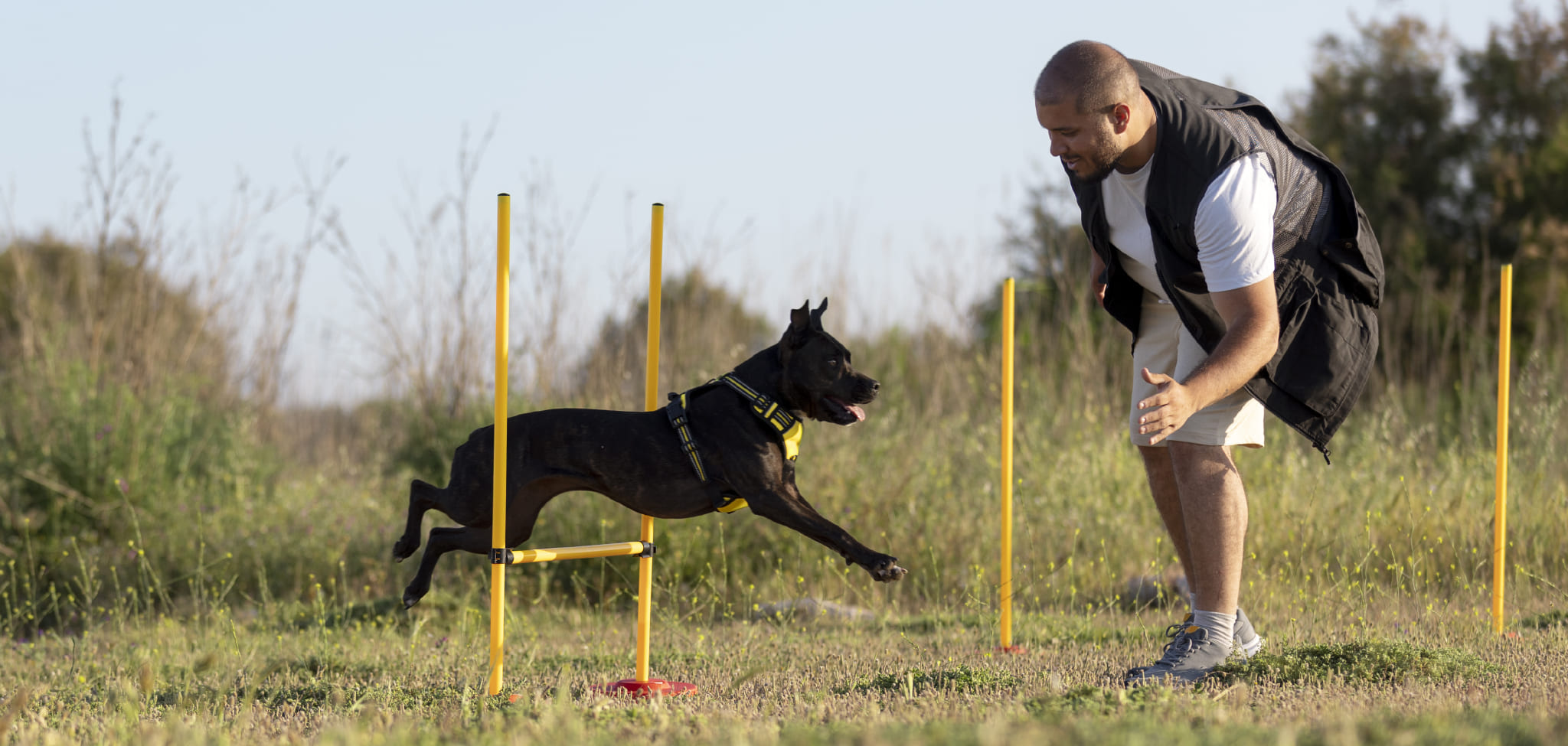Dog Training
As a dog owner, you understand the importance of proper training and socialization for your furry friend. Training your dog not only helps them learn basic commands but also strengthens the bond between you and your canine companion. Whether you have a new puppy or an adult dog, it’s never too late to start training. In this comprehensive guide, we will explore the benefits of training, effective training techniques, and how to tackle common behavior issues. So let’s dive in and unleash the potential of your dog’s training journey!
Why Training Your Dog is Essential
Training your dog is not just about teaching them tricks; it is a foundation for a harmonious relationship and ensures their safety. Here are some key reasons why training your dog is essential:
- Safety: Dogs who respond to commands like “sit,” “stay,” and “come” are less likely to get into dangerous situations, such as running into traffic or approaching aggressive dogs.
- Bonding: Training sessions provide an opportunity for you and your dog to spend quality time together, strengthening your bond and deepening your connection.
- Behavioral Issues: Proper training can help address behavioral issues like excessive barking, aggression, and destructive chewing, making your dog a well-mannered member of the family.
- Socialization: Training your dog helps them become comfortable around other people, animals, and different environments, reducing the likelihood of fear or aggression.
- Mental Stimulation: Dogs are intelligent creatures that thrive on mental stimulation. Training exercises challenge their minds and prevent boredom, leading to a happier and healthier dog.
“Proper training can help address behavioral issues like excessive barking, aggression, and destructive chewing, making your dog a well-mannered member of the family. For more information on maintaining your dog’s overall well-being, including health and nutrition care, check out our article on Health and Nutrition Care for Dogs“
Understanding How Dogs Learn
To effectively train your dog, it’s crucial to understand how they learn. Dogs are highly motivated by rewards and positive reinforcement. This means that when your dog exhibits a desired behavior, you reward them with something they value, such as treats, toys, or praise. This positive association encourages them to repeat the behavior in the future.
It’s important to identify what motivates your dog and tailor your training approach accordingly. Some dogs are food-oriented and will respond well to treats, while others may prefer playtime or verbal praise. Experiment with different rewards to find what works best for your furry friend.
Getting Started: The Basics of Dog Training
Before diving into specific commands and techniques, it’s important to establish a solid foundation for your dog’s training journey. Here are some essential steps to get started:
1. Set Clear Goals
Start by identifying your training goals. What specific behaviors do you want your dog to learn? Common goals include commands like sit, stay, lie down, come, and walking on a leash without pulling. Setting clear goals will help you stay focused throughout the training process.
2. Establish a Routine
Consistency is key when it comes to dog training. Establish a daily routine that includes regular training sessions. Keep the sessions short (about 5-10 minutes for puppies and 10-15 minutes for adult dogs) to maintain your dog’s attention and prevent them from getting overwhelmed.
3. Use Positive Reinforcement
Positive reinforcement is the most effective and humane training method. Reward your dog with treats, praise, or play whenever they exhibit the desired behavior. This positive association will motivate them to continue learning and obeying commands.
4. Start with Basic Commands
Begin with basic commands like sit and stay. These commands lay the foundation for more advanced training later on. Break down each command into small steps, rewarding your dog for incremental progress.
5. Be Patient and Consistent
Training takes time and patience. Dogs learn at different rates, so don’t get discouraged if your dog doesn’t grasp a command right away. Stay consistent with your training approach and provide regular reinforcement to help your dog succeed.
Training Tips for Success
To ensure successful training sessions, here are some valuable tips to keep in mind:
- Minimize Distractions: When introducing new commands or techniques, start in a quiet and familiar environment to minimize distractions. As your dog becomes more proficient, gradually increase the level of distractions to generalize their training.
- Use Positive Associations: Create positive associations with training by using high-value treats, toys, or praise. This will make the training experience enjoyable for your dog and increase their motivation to learn.
- Break it Down: Break complex commands into smaller, manageable steps. This allows your dog to understand and execute each step before moving on to the next. Gradually build up to the complete command.
- End on a Positive Note: Always end training sessions with a command your dog knows well and can successfully perform. This reinforces their confidence and leaves them with a positive association with training.
- Have Fun: Training should be a fun and enjoyable experience for both you and your dog. Incorporate games and interactive play into your sessions to keep them engaging and exciting.
Mastering Basic Commands
Mastering basic commands is essential for effective communication and control over your dog. Here are some key commands to focus on:
1. Sit
Teaching your dog to sit is one of the first and most important commands. It establishes control and is useful in various situations. Follow these steps to teach your dog to sit:
- Hold a treat close to your dog’s nose, then slowly move your hand upwards. As your dog follows the treat with their nose, their bottom will naturally lower into a sitting position.
- As soon as your dog sits, say “sit” and reward them with the treat and praise.
- Repeat this process multiple times, gradually phasing out the treat and relying more on verbal cues and praise.
2. Stay
The “stay” command teaches your dog to remain in one place until released. It is especially useful for situations that require your dog to stay put, like when a door is opened or when guests arrive. Follow these steps to teach your dog to stay:
- Start with your dog in a sitting position.
- Hold your hand up, palm facing towards your dog, and say “stay.”
- Take a step back, then immediately step back to your dog. If they remain in the sitting position, reward them with a treat and praise.
- Gradually increase the distance and duration of the stay, rewarding your dog for successfully staying in place.
3. Lie Down
The “lie down” command is useful for situations where you want your dog to settle down, such as when you’re having a meal or when they need to calm down. Follow these steps to teach your dog to lie down:
- Start with your dog in a sitting position.
- Hold a treat close to their nose, then slowly move your hand downwards towards the ground. As your dog follows the treat, their body will naturally lower into a lying down position.
- As soon as your dog lies down, say “lie down” and reward them with the treat and praise.
- Repeat this process multiple times, gradually phasing out the treat and relying more on verbal cues and praise.
4. Come
The “come” command is crucial for your dog’s safety and allows you to call them back to you in any situation. Follow these steps to teach your dog to come:
- Choose a quiet, secure area for training.
- Get down to your dog’s level and say their name followed by the command “come” in an enthusiastic tone.
- Open your arms wide, encouraging your dog to come towards you.
- When your dog reaches you, reward them with a treat and praise.
- Gradually increase the distance between you and your dog, practicing the “come” command in different environments and with increasing distractions.
By mastering these basic commands, you establish a strong foundation for further training and ensure better control over your dog in various situations.
Solving Common Behavior Problems
Dog training also involves addressing common behavior problems that may arise. Here are some effective strategies to tackle common issues:
1. Excessive Barking
Excessive barking can be a nuisance and may indicate underlying issues like boredom, fear, or territorial behavior. To address excessive barking:
- Identify the triggers for barking and work on desensitizing your dog to those triggers.
- Teach your dog the “quiet” command. When they stop barking on command, reward them with treats and praise.
2. Aggression
Aggression towards people or other dogs can be dangerous and requires professional assistance. Consult a qualified behaviorist or trainer who specializes in aggression issues to develop a behavior modification plan.
3. Destructive Chewing
Destructive chewing is a common problem, especially for puppies. To address destructive chewing:
- Provide appropriate chew toys and redirect your dog’s chewing behavior to those toys.
- Ensure your dog has plenty of physical and mental stimulation to prevent boredom.
Remember, consistency, positive reinforcement, and patience are key when addressing behavior problems. Seek professional help if needed, especially for complex issues.
Taking Training to the Next Level
Once your dog has mastered the basic commands, you can take their training to the next level by introducing more advanced tricks and activities. Here are a few ideas to challenge your dog mentally and physically:
- Fetch: Teach your dog to fetch and retrieve objects, gradually increasing the distance and complexity of the task.
- Puzzle Toys: Use interactive puzzle toys to keep your dog mentally stimulated and engaged. These toys require problem-solving skills and provide a rewarding challenge.
- Agility Training: Set up an agility course in your backyard or join an agility class. This activity not only provides physical exercise but also enhances your dog’s coordination and focus.
- Nose Work: Engage your dog’s sense of smell by teaching them to search for hidden objects or participate in scent detection activities.
Remember to always consider your dog’s physical abilities and limitations when introducing new activities. Supervise them during training and ensure their safety at all times.
The Role of Professional Trainers
While training your dog yourself is possible, enlisting the help of a professional trainer can be beneficial, especially for more complex training needs or behavior issues. Trainers have the expertise to assess your dog’s behavior, develop customized training plans, and provide guidance and support throughout the process.
Consider attending group training classes or seeking private sessions with a qualified trainer. They can provide valuable insights, address specific concerns, and help you refine your training techniques.
Additional Resources for Dog Training
To further enhance your dog’s training journey, here are some additional resources you can explore:
- Online Training Courses: Access training materials, videos, and step-by-step guides from renowned dog trainers.
- Books on Dog Training: Explore a wide range of books on dog training techniques and methods to deepen your knowledge.
- Dog Training Apps: Discover smartphone apps that offer training exercises, tracking tools, and interactive games for your dog.
Remember to choose resources that align with positive reinforcement training methods and always consult with a professional if you have specific concerns or questions.
FAQs about Dog Training
How often should I train my dog?
Consistency is key when it comes to training. Aim for short, regular training sessions throughout the week rather than long, infrequent sessions. This helps maintain your dog’s focus and prevents them from getting overwhelmed.
My dog is not motivated by treats. What should I do?
While treats are a common motivator, every dog is unique. Experiment with different rewards such as praise, playtime, or toys to find what truly motivates your dog. Some dogs may respond better to verbal praise or a favorite toy.
Can I train an older dog?
Absolutely! Dogs of all ages can learn and benefit from training. While puppies may have a shorter attention span, older dogs can still learn new commands and behaviors with patience and consistency.
Should I use punishment in dog training?
Positive reinforcement is the most effective and humane training method. Punishment can lead to fear, anxiety, and aggression in dogs. Focus on rewarding desired behaviors rather than punishing unwanted behaviors.
How long does it take to train a dog?
The duration of training varies depending on the dog’s breed, age, temperament, and previous training experiences. Consistent training, patience, and positive reinforcement can yield results within a few weeks to several months.
Conclusion
Training your dog is a rewarding journey that strengthens the bond between you and your furry friend. By understanding how dogs learn and implementing positive reinforcement techniques, you can effectively teach your dog basic commands and address common behavior issues. Remember to be patient, consistent, and always prioritize your dog’s well-being and happiness. With dedication and the right approach, you can unleash the full potential of your dog’s training capabilities. So let’s embark on this training adventure together and watch your dog thrive!
RECENT POSTS
History of Baseball
History of Baseball: From Its Origins to Modern TimesBaseball is one of the most popular sports in the United States, with millions of fans tuning in to watch games each year. The sport has a [...]
Hunting Falconry
History of Hunting Falconry: An Overview of Falconry's Evolution and Significance Are you interested in learning about the ancient practice of hunting with trained birds of prey? Falconry has been practiced for thousands of [...]
Hunting Destinations in 2024
Hunting Destinations in 2024: Top Picks for Avid Hunters Are you looking for exciting hunting destinations to explore in 2024? Whether you're a seasoned hunter or just starting, there are plenty of options available [...]
History of hunting dogs
Explore the History and Significance of Hunting Dogs: A Comprehensive Guide If you're a hunting enthusiast, then you know the importance of having a reliable hunting dog by your side. Hunting dogs have been [...]
Hunting as a Hobby
Hunting as a Hobby: An Overview Hunting is a popular outdoor activity enjoyed by millions of people worldwide. While some hunt for food, others do it as a hobby. Hunting as a hobby can [...]










